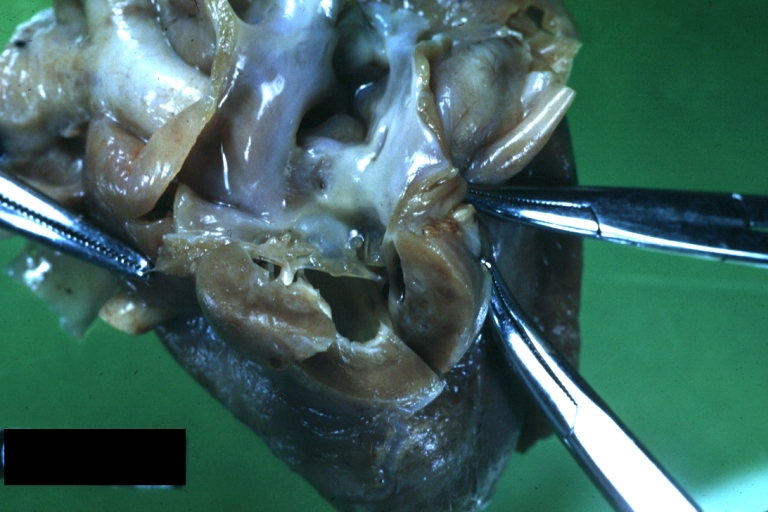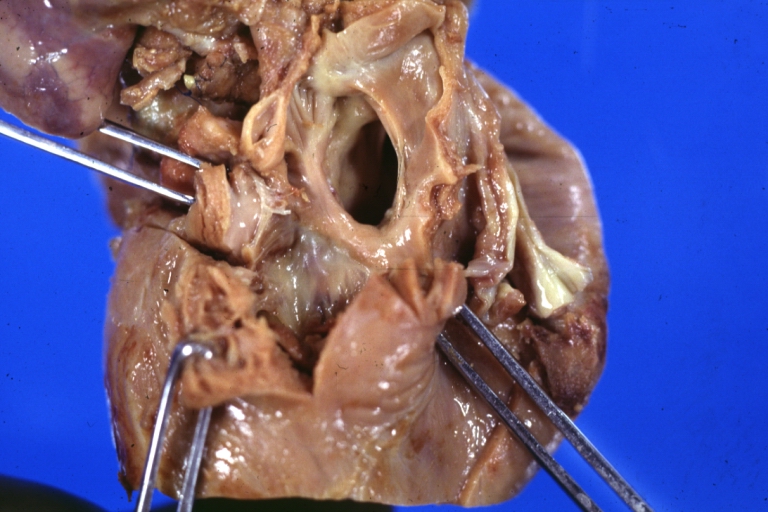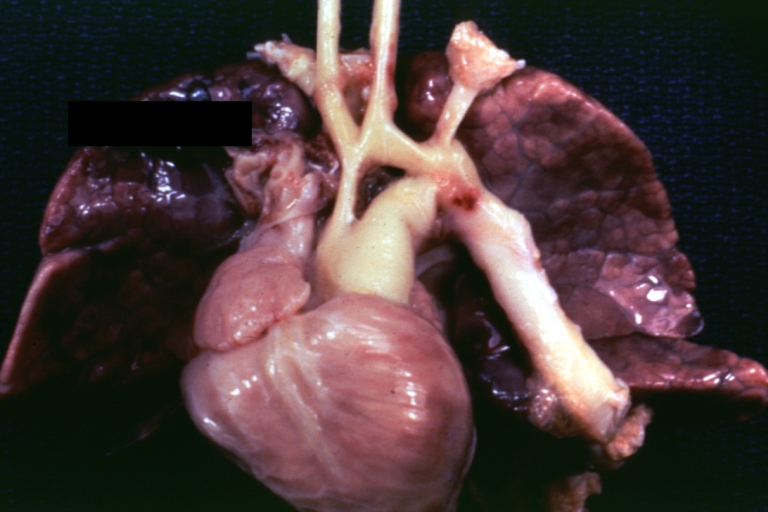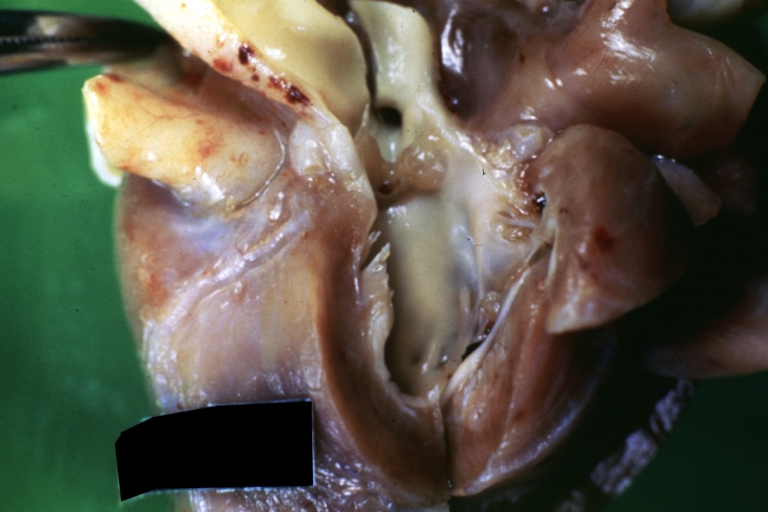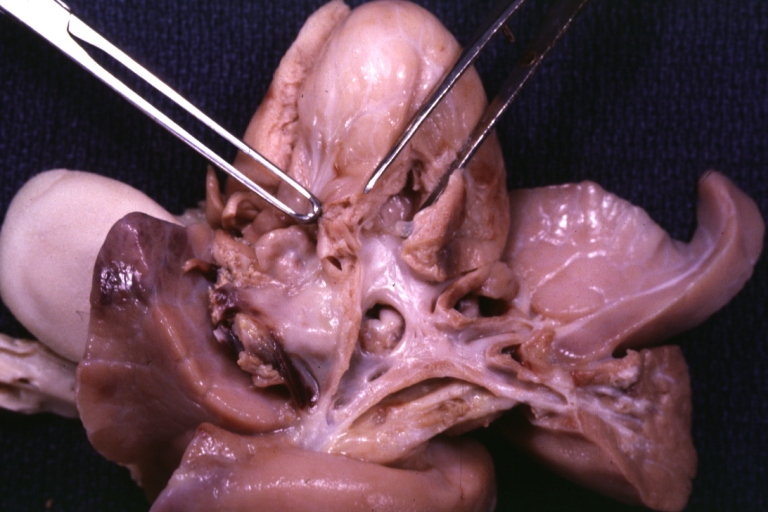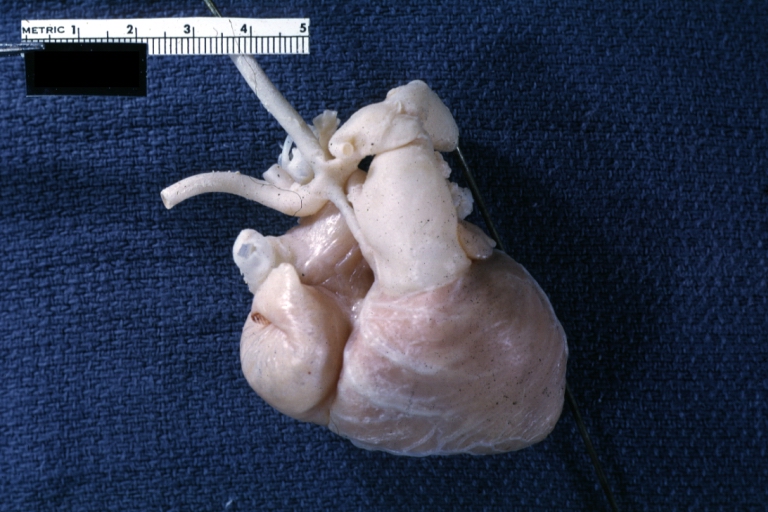Hypoplastic left heart syndrome: Difference between revisions
No edit summary |
No edit summary |
||
| Line 24: | Line 24: | ||
==Overview== | ==Overview== | ||
[[Hypoplastic left heart syndrome]] (also known as HLHS), is a rare [[congenital heart defect]] in which the left side of the [[heart]] is severely underdeveloped. In babies with HLHS, the [[aorta]] and [[left ventricle]] are very small, and the [[aortic valve|aortic]] and [[mitral valve]]s are either too small to allow sufficient blood flow or are atretic (closed) altogether. As [[blood]] returns from the [[lung]]s to the [[left atrium]], it must pass through an [[atrial septal defect]] to the right side of the heart. | [[Hypoplastic left heart syndrome]] (also known as HLHS), is a rare [[congenital heart defect]] in which the left side of the [[heart]] is severely underdeveloped. In babies with HLHS, the [[aorta]] and [[left ventricle]] are very small, and the [[aortic valve|aortic]] and [[mitral valve]]s are either too small to allow sufficient blood flow or are atretic (closed) altogether. As [[blood]] returns from the [[lung]]s to the [[left atrium]], it must pass through an [[atrial septal defect]] to the right side of the heart. | ||
| Line 31: | Line 32: | ||
==Treatment== | ==Treatment== | ||
The two methods for treatment of HLHS are transplantation and a | Without treatment, HLHS is fatal, but with intervention, an infant may survive. A [[pediatric]] [[cardiothoracic surgeon]] may perform a series of operations or a full [[heart transplant]]. In the meantime, the ductus may be kept open to allow bloodflow using medication containing [[prostaglandin]]. Because these operations are complex and need to be individualized for each patient, a cardiologist must assess all medical and surgical options on a case-by-case basis. | ||
After assessment the child's parents are given a percentage chance of survival and the choice of surgery or to take the child home to pass away. | |||
The two methods for treatment of HLHS are transplantation and a three-stage surgical procedure. Each of these are open heart surgeries (meaning the chest is open and the [[sternum]] has to be separated), requiring the child to be on a heart bypass machine for at least five hours. The heart is stopped and the heart bypass machine pumps blood to the body. After successful surgery is performed there can be added complications of restarting the heart and getting the child off the heart bypass machine. | |||
The three-stage procedure is a [[Palliative care|palliative]] procedure (not a cure), as the child's circulation is made to work with only two of the heart's four chambers. | |||
* The first step is the [[Norwood procedure]]. In this procedure, the right ventricle is used to pump blood into the systemic circulation. Since the right ventricle is no longer directly pumping blood to the lungs, a shunt is required in order to pass deoxygenated blood through the lungs. Either the subclavian artery can be connected to the pulmonary circulation (Blalock-Taussig shunt), or a shunt is made directly from the right ventricle to the pulmonary circulation (Sano shunt). The narrow aorta is enlarged using a patch to improve bloodflow to the body. | |||
During this time the baby may be medically fragile and have feeding problems because the heart is working very hard. There is a considerable degree of venous mixing in the right ventricle, leading to lower oxygenation saturations. In addition, the Blalock-Taussig shunt and the Sano shunt both expose the lungs to systemic arterial pressures, leading in the long term to pulmonary hypertension and eventually to heart failure. | |||
* The second stage, the bi-directional Glenn procedure or Hemi-Fontan (see also [[Kawashima procedure]]) relieves some of the above problems. In this operation, the superior vena cava is ligated from the heart and connected to the pulmonary circulation. At this time, the Blalock-Taussig or Sano shunt is taken down. At this point, the lungs are no longer exposed to systemic arterial pressures, but much lower venous pressures. Although venous blood from the upper half of the body is no longer mixing with oxygenated blood in the right ventricle, there is still venous mixing from the lower half of the body, leading to some degree of oxygen desaturation. | |||
During this time the child may have improved quality of life as the heart does not have to work as hard. | |||
* The final procedure, the Fontan ([[Fontan procedure]]) completes the repair of the hypoplastic left heart. Although there are several variations, the functional effect is to redirect venous blood from the lower body (through the inferior vena cava) away from the right atrium to the pulmonary artery. Now, there should not be any mixing of oxygenated and deoxygenated blood in the right ventricle. The right ventricle performs the traditional job of the left, supplying the body with oxygenated blood, while the passive systemic venous pressure performs the traditional job of the right, passing deoxygenated blood to the lungs. | |||
The Norwood Procedure is generally performed within a week of birth, the second stage at 3–6 months of age, and the Fontan at 18 months to four years of age. There are two types of Fontan: the Lateral Tunnel Fontan, and the Extracardiac Fontan. When the Fontan Procedure was first being done for children with HLHS, the only Fontan was the Lateral Tunnel Fontan. This requires actual cutting in the heart itself to create a "tunnel" by which the blood can travel passively to the lungs. Within the last decade, doctors have created an Extracardiac Fontan. This operation creates a tunnel outside the heart itself which reduces the chances of Fontan patients developing scar tissue on the heart which might later cause arrythmias. | |||
==Prognosis== | ==Prognosis== | ||
While infants successfully treated for HLHS have a good chance of survival, they may experience chronic health problems for the rest of their lives. The 3-stage surgeries were developed in the early 1980's with no survivors prior to that time. Therefore, the earliest survivors are in their early 20's and the long term prognosis is unknown. However, the advances in surgical and medical techniques have helped increase the survival rate dramatically since the surgeries were first developed. | While infants successfully treated for HLHS have a good chance of survival, they may experience chronic health problems for the rest of their lives. The 3-stage surgeries were developed in the early 1980's with no survivors prior to that time. Therefore, the earliest survivors are in their early 20's and the long term prognosis is unknown. However, the advances in surgical and medical techniques have helped increase the survival rate dramatically since the surgeries were first developed. | ||
| Line 41: | Line 59: | ||
==Pathological Findings== | ==Pathological Findings== | ||
[http://www.peir.net Images courtesy of Professor Peter Anderson DVM PhD and published with permission © PEIR, University of Alabama at Birmingham, Department of Pathology] | [http://www.peir.net Images courtesy of Professor Peter Anderson DVM PhD and published with permission © PEIR, University of Alabama at Birmingham, Department of Pathology] | ||
Revision as of 16:08, 2 April 2009
| Hypoplastic left heart syndrome | ||
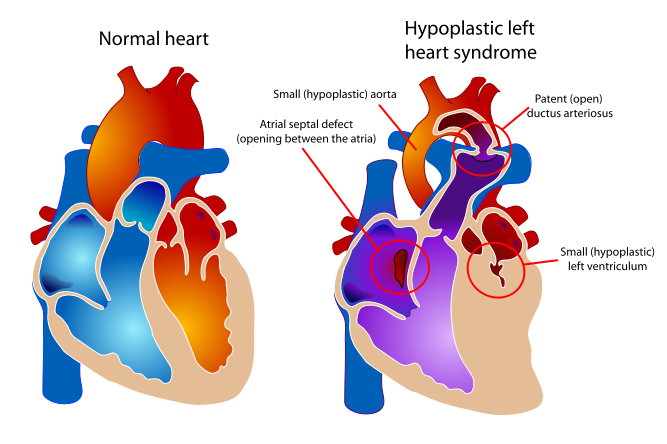 | ||
|---|---|---|
| Diagram of a healthy heart and one suffering from Hypoplastic left heart syndrome | ||
| ICD-10 | Q23.4 | |
| ICD-9 | 746.7 | |
| OMIM | 241550 | |
| DiseasesDB | 31507 | |
| MedlinePlus | 001106 | |
| eMedicine | ped/1131 | |
| MeSH | C14.240.400.625 | |
| Cardiology Network |
 Discuss Hypoplastic left heart syndrome further in the WikiDoc Cardiology Network |
| Adult Congenital |
|---|
| Biomarkers |
| Cardiac Rehabilitation |
| Congestive Heart Failure |
| CT Angiography |
| Echocardiography |
| Electrophysiology |
| Cardiology General |
| Genetics |
| Health Economics |
| Hypertension |
| Interventional Cardiology |
| MRI |
| Nuclear Cardiology |
| Peripheral Arterial Disease |
| Prevention |
| Public Policy |
| Pulmonary Embolism |
| Stable Angina |
| Valvular Heart Disease |
| Vascular Medicine |
Template:Search infobox Editor-In-Chief: C. Michael Gibson, M.S., M.D. [1]
Associate Editors-In-Chief: Cafer Zorkun, M.D., Ph.D. [2]; Keri Shafer, M.D. [3]
Please Join in Editing This Page and Apply to be an Editor-In-Chief for this topic: There can be one or more than one Editor-In-Chief. You may also apply to be an Associate Editor-In-Chief of one of the subtopics below. Please mail us [4] to indicate your interest in serving either as an Editor-In-Chief of the entire topic or as an Associate Editor-In-Chief for a subtopic. Please be sure to attach your CV and or biographical sketch.
Overview
Hypoplastic left heart syndrome (also known as HLHS), is a rare congenital heart defect in which the left side of the heart is severely underdeveloped. In babies with HLHS, the aorta and left ventricle are very small, and the aortic and mitral valves are either too small to allow sufficient blood flow or are atretic (closed) altogether. As blood returns from the lungs to the left atrium, it must pass through an atrial septal defect to the right side of the heart.
In a healthy human, the left side of the heart receives oxygen-rich blood from the lungs and pumps it out to the rest of the body; with these structures underdeveloped, they cannot circulate blood to other organs, and the right ventricle must pump blood to both the lungs, as it would normally, and to the rest of the body, a situation which cannot be sustained for long.
In cases of HLHS, the right side of the heart often must pump blood to the body through a patent ductus arteriosus. As the ductus arteriosus closes a few days after birth, blood flow is severely restricted and eventually cut off, leading to dangerously low circulation and eventually to shock.
Treatment
Without treatment, HLHS is fatal, but with intervention, an infant may survive. A pediatric cardiothoracic surgeon may perform a series of operations or a full heart transplant. In the meantime, the ductus may be kept open to allow bloodflow using medication containing prostaglandin. Because these operations are complex and need to be individualized for each patient, a cardiologist must assess all medical and surgical options on a case-by-case basis. After assessment the child's parents are given a percentage chance of survival and the choice of surgery or to take the child home to pass away.
The two methods for treatment of HLHS are transplantation and a three-stage surgical procedure. Each of these are open heart surgeries (meaning the chest is open and the sternum has to be separated), requiring the child to be on a heart bypass machine for at least five hours. The heart is stopped and the heart bypass machine pumps blood to the body. After successful surgery is performed there can be added complications of restarting the heart and getting the child off the heart bypass machine.
The three-stage procedure is a palliative procedure (not a cure), as the child's circulation is made to work with only two of the heart's four chambers.
- The first step is the Norwood procedure. In this procedure, the right ventricle is used to pump blood into the systemic circulation. Since the right ventricle is no longer directly pumping blood to the lungs, a shunt is required in order to pass deoxygenated blood through the lungs. Either the subclavian artery can be connected to the pulmonary circulation (Blalock-Taussig shunt), or a shunt is made directly from the right ventricle to the pulmonary circulation (Sano shunt). The narrow aorta is enlarged using a patch to improve bloodflow to the body.
During this time the baby may be medically fragile and have feeding problems because the heart is working very hard. There is a considerable degree of venous mixing in the right ventricle, leading to lower oxygenation saturations. In addition, the Blalock-Taussig shunt and the Sano shunt both expose the lungs to systemic arterial pressures, leading in the long term to pulmonary hypertension and eventually to heart failure.
- The second stage, the bi-directional Glenn procedure or Hemi-Fontan (see also Kawashima procedure) relieves some of the above problems. In this operation, the superior vena cava is ligated from the heart and connected to the pulmonary circulation. At this time, the Blalock-Taussig or Sano shunt is taken down. At this point, the lungs are no longer exposed to systemic arterial pressures, but much lower venous pressures. Although venous blood from the upper half of the body is no longer mixing with oxygenated blood in the right ventricle, there is still venous mixing from the lower half of the body, leading to some degree of oxygen desaturation.
During this time the child may have improved quality of life as the heart does not have to work as hard.
- The final procedure, the Fontan (Fontan procedure) completes the repair of the hypoplastic left heart. Although there are several variations, the functional effect is to redirect venous blood from the lower body (through the inferior vena cava) away from the right atrium to the pulmonary artery. Now, there should not be any mixing of oxygenated and deoxygenated blood in the right ventricle. The right ventricle performs the traditional job of the left, supplying the body with oxygenated blood, while the passive systemic venous pressure performs the traditional job of the right, passing deoxygenated blood to the lungs.
The Norwood Procedure is generally performed within a week of birth, the second stage at 3–6 months of age, and the Fontan at 18 months to four years of age. There are two types of Fontan: the Lateral Tunnel Fontan, and the Extracardiac Fontan. When the Fontan Procedure was first being done for children with HLHS, the only Fontan was the Lateral Tunnel Fontan. This requires actual cutting in the heart itself to create a "tunnel" by which the blood can travel passively to the lungs. Within the last decade, doctors have created an Extracardiac Fontan. This operation creates a tunnel outside the heart itself which reduces the chances of Fontan patients developing scar tissue on the heart which might later cause arrythmias.
Prognosis
While infants successfully treated for HLHS have a good chance of survival, they may experience chronic health problems for the rest of their lives. The 3-stage surgeries were developed in the early 1980's with no survivors prior to that time. Therefore, the earliest survivors are in their early 20's and the long term prognosis is unknown. However, the advances in surgical and medical techniques have helped increase the survival rate dramatically since the surgeries were first developed.
As is true for patients with other types of heart defects involving malformed valves [5], HLHS patients run a high risk of endocarditis, and must be monitored by a cardiologist for the rest of their lives to check on their heart function.
Pathological Findings
External links
- Hypoplastic Left Heart Syndrome information from Seattle Children's Hospital Heart Center
- Congenital Heart Information Network
- HLHS Information Page - created for parents expecting a child with HLHS. Includes questions to ask the physicians and insurance company.
- California Heart Connection - support network for those with congenital heart defects including Hypoplastic Left Heart Syndrome (HLHS.) Free online support group
Sources
- Card-AG, The Cardiologycal Working Group of the University Pediatric Clinic Munster
- Hypoplastic Left Heart Syndrome, American Heart Association
- Information on HLHS from the Cincinnati Children's Hospital Medical Center, accessed 9 July, 2006
- Hypoplastic Left Heart Syndrome - University of Michigan Congenital Heart Center
Template:SIB de:Hypoplastisches Linksherz-Syndrom nn:Hypoplastisk venstre hjarte-syndrom uk:Синдром гіпоплазії лівих відділів серця
